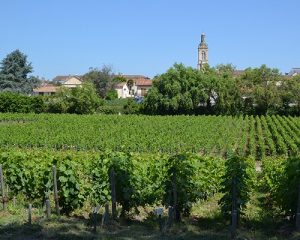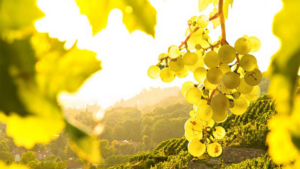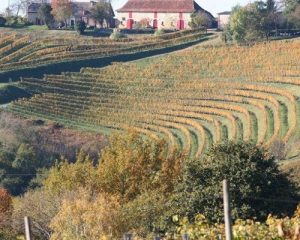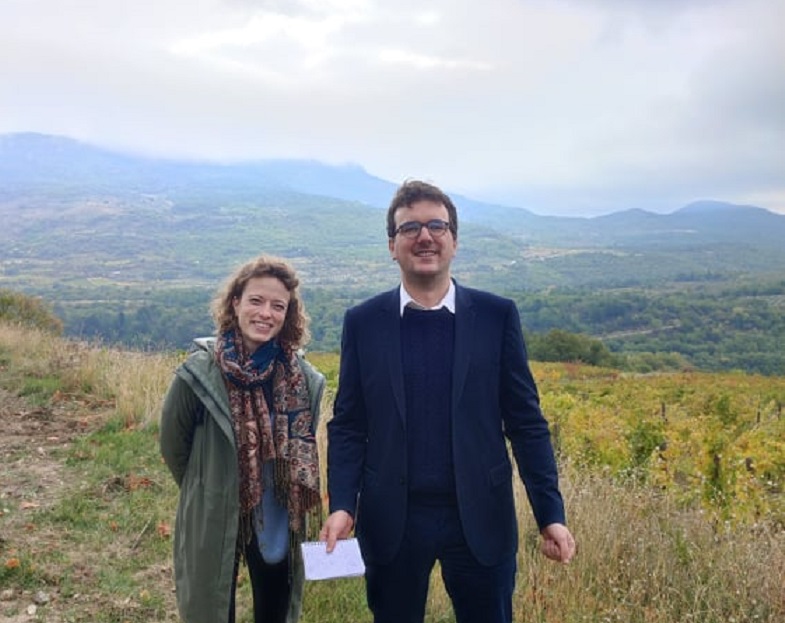
We recounted the first day of our southern adventures last week and, as promised, here is the next instalment. Day 2 brought visits to no less than four wine estates: Domaine de Montcalmès, Domaine du Mas Jullien, Domaine Coston, and La Terrasse d’Elise.
Domaine de Montcalmès
An early start saw us with a full glass at 7.30 in the morning…the things we do for you! This sunrise tasting was directly from the cask, so they were young but already excellent. The blend of this domain’s best-known cuvée, ‘Terrasses du Larzac’, is another classic one for this vintage (60% Syrah, 20% Mourvèdre, 20% Grenache), confirming its stability as the years go on. This marvel of a cuvée makes up 80% of the estate’s total production, with the remaining 20% crafted depending on the vintage, the volumes, and the quality available. There is an experimental approach to these wines, with certain barrels picked for their distinctive nature or interesting qualities.
Whilst the work of this vigneron stands on its own as proof of true talent and excellence, it’s worth citing just a few of the other domains Frédéric Portalié has learnt from: Grange des Pères, Mas Jullien, Alain Graillot…you get the idea, there’s no scepticism here about the credentials of such a wine maker.
Domaine de Montcalmès stretches across four villages around Aniane, Puéchabon, Saint-Jean-de-Fos, and Saint-Saturnin-de-Lucian. This is a spot that enjoys a maritime influence from the Mediterranean, cool air that comes down from the Larzac, and a terrain of varied elevation; the terroir here is beautifully diverse. Whilst the blend is dominated by Puéchabon’s Syrah, grown on north-facing, limestone-rich soils that confer a characteristic freshness to the wine, we also find pebbled earth not unlike Châteauneuf, a profile that adds complexity to the cuvées. The domain has held organic certification since 2015, and collects low yields (20 hectolitres/hectare) followed by a careful vinification using native yeasts.
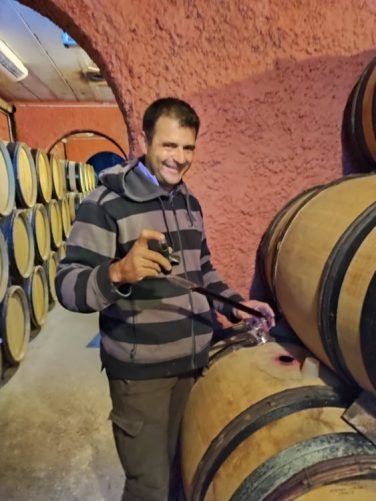 Frédéric Pourtalié talked to us about his 2021 vintage, difficult to manage during spells of frost and summer rain. As you can imagine, this was a sentiment shared by many neighbouring wine growers in the region. However, many of them have got through the year surprisingly well, with vines having resisted the tricky conditions. According to Frédéric, the frost may have even improved the quality of his fruit, as some of the vines grew fewer bunches; this made the flavours and aromas in each more concentrated. Plus, the rainy periods always fell during opportune moments in the plant cycle. Having said this, smaller quantities call these advantages into question…we all have to make a living after all. And a rainy summer demands more manual labour when it comes to weeding. At Montcalmès, Frédéric imagines his 2021 vintage will be like the 2012 or 2014, less sunny and silkier, with delicate tannins. A ‘Burgundy-style’ vintage rather than a ‘Châteauneuf-esque’ one, if the comparison can help to shed some light.
Frédéric Pourtalié talked to us about his 2021 vintage, difficult to manage during spells of frost and summer rain. As you can imagine, this was a sentiment shared by many neighbouring wine growers in the region. However, many of them have got through the year surprisingly well, with vines having resisted the tricky conditions. According to Frédéric, the frost may have even improved the quality of his fruit, as some of the vines grew fewer bunches; this made the flavours and aromas in each more concentrated. Plus, the rainy periods always fell during opportune moments in the plant cycle. Having said this, smaller quantities call these advantages into question…we all have to make a living after all. And a rainy summer demands more manual labour when it comes to weeding. At Montcalmès, Frédéric imagines his 2021 vintage will be like the 2012 or 2014, less sunny and silkier, with delicate tannins. A ‘Burgundy-style’ vintage rather than a ‘Châteauneuf-esque’ one, if the comparison can help to shed some light.
We kicked off our tasting with the domain’s little white (just 6,000 bottles a year), a blend of 2020 Marsanne and Roussanne. A really good wine with a nice acidity and a minerality that brightened up our morning 😊. Just afterwards, we tried a 2019 Grenache from lakeside limestone soil. Cold clarification and no filtering made for a good attack on the palate and delightful fruit. Next, we were struck by the silky character of the 2019 Cinsault. A wine extracted as delicately as possible to conserve its finesse in the face of the vintage’s heatwave, when temperatures reached 46°C on the 29th of June! More of an infusion than an extraction…
This silky mouthfeel is a common feature in the wines we tried, including a 2019 Syrah from vines grown in pebbly soil; we found this one especially charming. Another Syrah, this one planted in lake limestone terroir, caught our attention with its contrasting freshness and salinity, features that stem from the seabed that folded to become the Massif Central. Yet another flavour profile comes from the Syrah cultivated in limestone soil (not lake stone this time), and we loved its spicey side and its full texture on the palate. Finally, the Mourvèdre we tasted was superbly elegant, and we can’t wait to try it once it’s bottled!
We finished off with…a breakfast chouquette. We’ll save you the tasting notes for that one, but know that it got our morning off to the perfect start. Since the sun was rising, it was time to move on to our next domain in Joncquières, where we were expected at Mas Jullien.
Mas Jullien
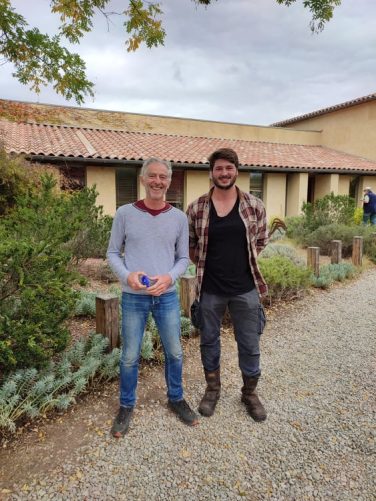 Arriving at Mas Jullien, we were warmly welcomed by Olivier Jullien and Paul-Clément Tesson, his right-hand man and our enthusiastic guide through the vineyards and winery. Just 26 years old, this oenologist from Normandy wanted to learn hands-on about biodynamics from an expert in the field, and there’s no doubt that he ended up in the right place. At Mas Jullien, listening to the vines and their surroundings, feeling and wisdom are all central to the work that takes place. The family vibe adds a charm to the place, too, and it was a touching visit.
Arriving at Mas Jullien, we were warmly welcomed by Olivier Jullien and Paul-Clément Tesson, his right-hand man and our enthusiastic guide through the vineyards and winery. Just 26 years old, this oenologist from Normandy wanted to learn hands-on about biodynamics from an expert in the field, and there’s no doubt that he ended up in the right place. At Mas Jullien, listening to the vines and their surroundings, feeling and wisdom are all central to the work that takes place. The family vibe adds a charm to the place, too, and it was a touching visit.
Putting the qualifications on the table, the domain has organic certification, and though their biodynamic practices aren’t official, we don’t need the piece of paper to see how these methods guide their winemaking entirely. A bird’s eye view of the estate would show two blocks of vines grown by Olivier and Paul-Clément, though the different terroirs they cover are myriad. Two thirds of the plants are around Joncquières, and the remaining third grow near Saint-Privas. It was the latter that we were lucky enough to wander through, where the Carlan and Lous Rougeos parcels provide fruit for their eponymous cuvées.
Even to the naked eye, the difference between the land at Joncquières and Saint-Privas is striking, with the earth becoming a lot redder and oxidated the further you look. Olivier is always on the hunt for new terroirs to experiment with and has built up his Lous Rougeos parcel bit by bit; this lofty spot in the heights Saint Privas is mountainous with a view looking out to the luscious plain below.
Still on foot, a path led us to a part of the vineyard that only added to the marvel we felt, and we discovered the Carlan parcel, a treasure trove at the end of our mindful walk. Planted with Grenache, Cinsault, Carignan, and soon Mourvèdre, too, this plot makes a kind of clearing in the heart of the slope’s forest. Mas Jullien is as much a treat for the eyes as it is for the taste buds!
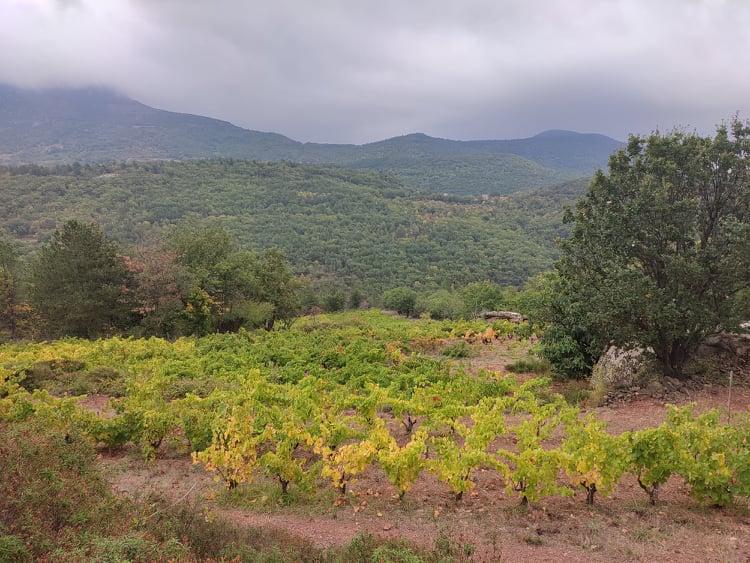
Originally, these parcels weren’t acquired with single cuvées in mind, rather their grapes were to be used only in blends. However, time and effort have shown strong potential in this land, and it’s clear that the terroirs are good enough to produce fine wines on their own terms. The same goes for the Joncquières wines that have seen their quality improve nicely over the years, largely thanks to the maturing of the vines.
Moving on to the wines themselves, most that we tried were already bottled here, and we give you a glimpse of our impressions below:
Mas Jullien blanc 2019: an increasingly rare blend of mainly Carignan blanc with Chenin and Viognier. It was love at first taste for this one, as testified by the ‘SUPERBE’ written diagonally across the notebook of yours truly.
La brune 2018: this one seems to be Paul-Clément’s favourite! A wine with a crisp attack, a lovely texture on the palate, pleasant acidity, and a touch of bitterness on the finale that elegantly ties together a fresh, fruity, and floral mouthful. The cuvée will pair well with a piece of meat; its tannins are soft and supple.
Lous Rougeos rouge 2019: back to this gorgeous parcel with a wine made up of 50% Carignan and smaller proportions of Syrah, Grenache, and Cinsault. The nose, subtle to begin with, opens gradually to give off notes of forest fruits. On the palate, this cuvée has quite marked tannins and texture, conferring excellent ageing potential.
Carlan 2020: a fresh cuvée that’s a bit too austere for the moment. It leans on cherry and raspberry based profile and is sure to be enjoyable!
We got to taste many more of the domain’s wines, and we’d sum up by saying that we loved the white cuvée straight away, and the reds had beautiful length on the palate. At lunch with Olivier and Paul-Clément, we enjoyed a Monts-Damnés from Dagueneau and a 1996 Mas Jullien (a wine that ages amazingly!) and chatted about the appellation’s history.
Next up was a domain whose wines we don’t yet have in our selection…but they’re sure to be featured soon.
Domaine Coston
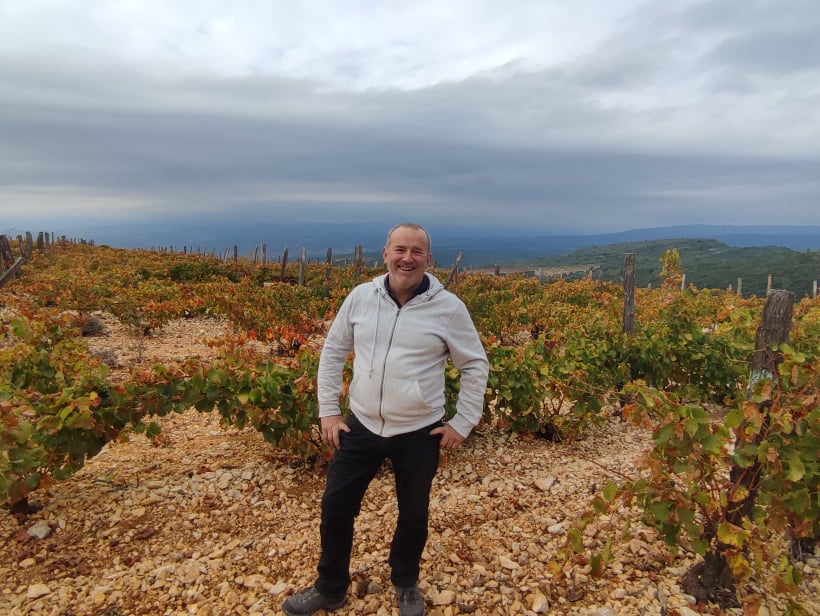 Jean-Marc Coston invited us to his domain in a superbly located spot called Arboussas, where we find a pretty well-known parcel…well-known because it was this plot of land that became highly coveted at the beginning of the century, inspiring the film Mondovino. This Jonathan Nossiter creation doesn’t, however, recount the end of the story, when Jean-Marc and his brother were chosen to settle at the estate, against other domains and even Mondavi. But even after this choice was made, the brothers weren’t in the clear, and setting up their estate turned out to be complicated. We were all ears as Jean-Marc recounted their side of the surreal story, which involved the Aniane council, rural planners, and other powers that be. And this isn’t the only dispute to fall on Arboussas, as even the Pope has had cause to intervene in issues on the land when shepherds and Benedictine monks were resident there…But we’ll save these stories for another day.
Jean-Marc Coston invited us to his domain in a superbly located spot called Arboussas, where we find a pretty well-known parcel…well-known because it was this plot of land that became highly coveted at the beginning of the century, inspiring the film Mondovino. This Jonathan Nossiter creation doesn’t, however, recount the end of the story, when Jean-Marc and his brother were chosen to settle at the estate, against other domains and even Mondavi. But even after this choice was made, the brothers weren’t in the clear, and setting up their estate turned out to be complicated. We were all ears as Jean-Marc recounted their side of the surreal story, which involved the Aniane council, rural planners, and other powers that be. And this isn’t the only dispute to fall on Arboussas, as even the Pope has had cause to intervene in issues on the land when shepherds and Benedictine monks were resident there…But we’ll save these stories for another day.
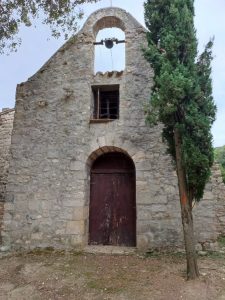 In any case, once they’d got over these (not insignificant) stumbling blocks, a project of 20 years could begin, and the wine growers got stuck in with clearing almost inaccessible terrain, planting vines, and establishing biodynamic practices.
In any case, once they’d got over these (not insignificant) stumbling blocks, a project of 20 years could begin, and the wine growers got stuck in with clearing almost inaccessible terrain, planting vines, and establishing biodynamic practices.
An impressive view of the landscape greets us from the heights of the parcel. Perched as though it came down from the sky, a wave of vines follows the downward slope towards a wild valley. A Benedictine chapel also sits among the garrigue, a centuries-old passing place for pilgrims on their way to Saint-Jacques-de-Compostelle. Domaine Coston is one of the lucky few to be planted on the Arboussas Massif, alongside Mas Daumas Gassac and la Grange des Pères. And despite this, the wines have remained at attainable prices!
We tasted:
Arboussas blanc 2020: lively and fruity with lovely aromas of citrus, white fruit, and even pear on the nose. On the palate, this is an ample and flavourful cuvée with nice texture.
Languedoc blanc 2020: made from Grenache blanc and Roussanne, fatter and ampler, though it still has a nice acidity to it.
Les Garigoles rouge 2019: rich in dark fruits with hints of spice and a thyme, made from Grenache, Syrah, and some Mourvèdre from a Puéchabon parcel that belongs to the parents of the Coston brothers. Deep and elegant on the palate, a cuvée that can easily be aged for a decade in the cellar.
Arboussas rouge 2019: back to the famous parcel for a cellaring wine made from Syrah, Grenache, and a bit of Cinsault planted in limestone soil. This cuvée is distinctive for the length of its ripe dark fruit, its herby aromas, and its ample mouthfeel.
Get ready, as we’ll have some for you very soon!
With the day rushing on, we still had one meeting to get to, and sped along to La Terrasse d’Elise, where Xavier Braujou was waiting for us.
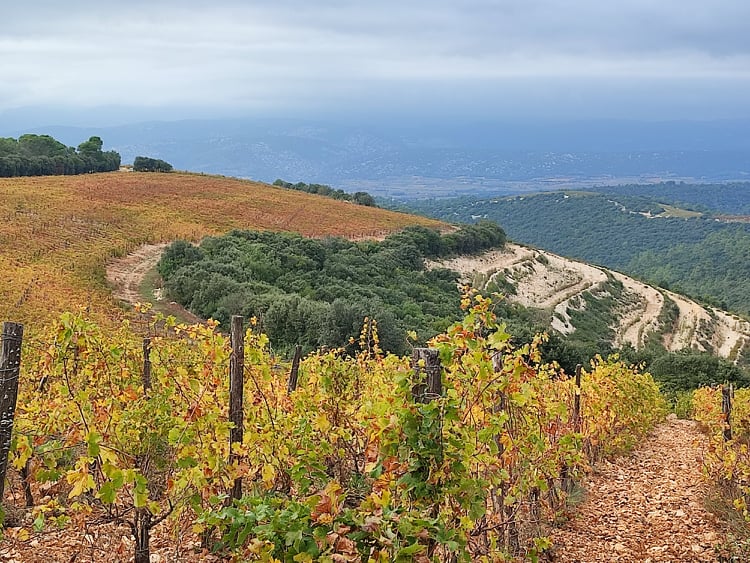
La Terrasse d’Elise
We’ve been working with Terrasse d’Elise for a long time, so introductions have already been made, but it’s always a pleasure to retaste the estate’s cuvées. Everything we saw and tried was of the highest quality. Fans of silky textures will be blown away by the velvety precision in the cuvées developed by Xavier Braujou.
It was a privilege to visit the winery, where we certainly didn’t recognise all of the wonderful varieties being vinified, as some of them were served blind…always a fun little exercise for the taste buds! The original and delicious cuvée from Terrasse d’Elise was originally made for Xavier’s personal consumption, and it’s made from Sangiovese, so we didn’t feel too bad for not guessing correctly.
It’s worth noting that these wines aren’t filtered and very little sulphur is added, as the estate is run organically and biodynamically, though without certification.
K’yenne 2020: a blend of Roussanne and Marsanne grown in limestone soils, we really loved this one. It carries aromas of peach, plum, and flowers, with an invigorating acidity balanced out by a nice buttery side. This balance makes it wonderfully easy to drink.
Haut de Carols 2020: a Cinsault from mature vines (45 – 60 years old). A wine with great finesse and the touch of brightness characteristic of this domain.
Haut de Carols 2019: a floral wine with a voluntarily precise texture, subtle without lacking in feeling. Enveloped in a lovely fruitiness, we really liked this one.
We also got the chance to taste various wines directly from the cask, and a special mention has to go to the Cinsault and Carignan barrels. The underlying common factor throughout these wines is a finesse with remarkable texture, crisp fruit and a marked precision. All that’s left is for you to have a taste for yourselves, we’re sure you won’t be disappointed!
That concludes our second day in the Languedoc, a 13-hour extravaganza of tasting wine, meeting friendly vignerons, and enjoying the region’s sublime landscapes.

